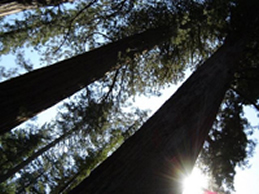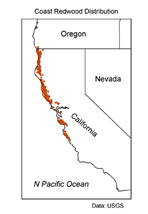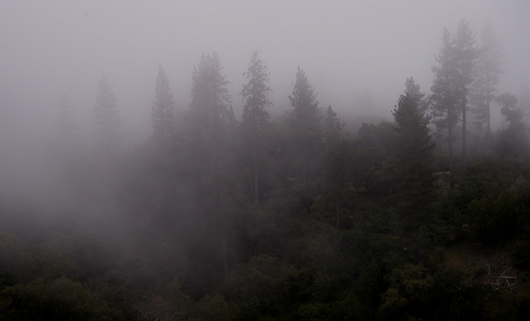Plant Profile: Coast redwood (Sequoia sempervirens)
22.02.10
The tallest trees on earth and the last surviving member of the genus Sequoia may be under threat. Jamie McCormack, a self-confessed Cone-head, of the Eden Project investigates these ancient organisms.
What's in a name? According to Quattrocchi's CRC World Dictionary of Plant Names the word Sequoia is dedicated to George Gist (ca1760-1843), the creator of the Cherokee alphabet and writing system. He was also variously known as Soquoiah, Sequoyah, Sequoiar, Sequoiah, Sequoya, or Se-Quo-Yah and sikwayi is the Cherokee name for the opossum. It's probably the only Cherokee word that's become a common part of the English vocabulary.
Sempervirens, however, is rather easier to pin down. It means Evergreen.

Coast redwood trees in California. Reaching heights of up to 120m and diameters of 8m they are found in southwest Oregon all the way to Big Sur in California.
These monsters of the tree-world can weigh up to 730,000kg meaning they are some of the biggest living things in the Earth's history.
© Jamie McCormack
 Habitat It's estimated up to 95% of the original redwood forest has been logged and of the remaining forest only 18% is properly protected within a park or reserve. Redwood National Park was inscribed as a UNESCO World Heritage Site in 1980 and coast redwoods are listed as Vulnerable on the IUCN Red List.
Habitat It's estimated up to 95% of the original redwood forest has been logged and of the remaining forest only 18% is properly protected within a park or reserve. Redwood National Park was inscribed as a UNESCO World Heritage Site in 1980 and coast redwoods are listed as Vulnerable on the IUCN Red List.
The oldest known tree is 2,200 years old!
Much of "Star Wars: Return of the Jedi" was filmed in Tall Trees Redwood Grove where it doubled as the Ewok planet Endor.
The tallest known tree was discovered in 2006 in Redwood National Park by Chris Atkins and Michael Taylor. It stands 115.55m tall and is called Hyperion. So far 33 measured trees have been discovered that stand over 110m.
Summer coastal fog is an essential part of the redwood ecosystem. A recent report in Proceedings of the National Academy of Sciences indicates that a reduction in fog since the early 20th century may have a negative impact on the redwood forest ecology.

Summer fog decreases water loss in the hot summer months. More work is needed to
understand whether modern changes in fog patterns will have an adverse effect on these
finely balanced ecosystems. © James A. Johnstone
Related links:
Plant Profile: Philodendron bipinnatifidum
18.02.10
 In this special two part feature Prof. Ghillean Prance and Dr. Hector Keller take a close look at Philodendron bipinnatifidum (Araceae) in the Atlantic Forest of Misiones, Argentina.
In this special two part feature Prof. Ghillean Prance and Dr. Hector Keller take a close look at Philodendron bipinnatifidum (Araceae) in the Atlantic Forest of Misiones, Argentina.
USA: Reduced summer fog may put redwoods in danger
17.02.10
 A new study has shown that declining summer fog along the Pacific coast may be affecting the mighty coast redwoods and other important ecosystems.
A new study has shown that declining summer fog along the Pacific coast may be affecting the mighty coast redwoods and other important ecosystems.